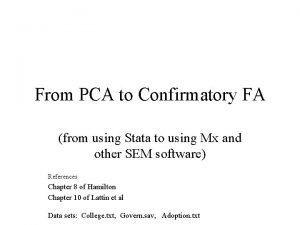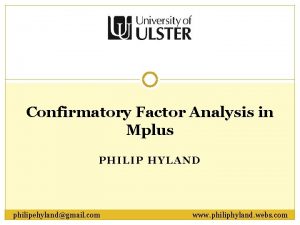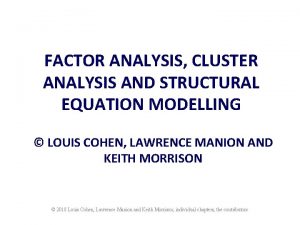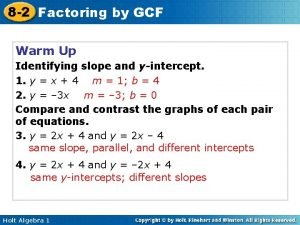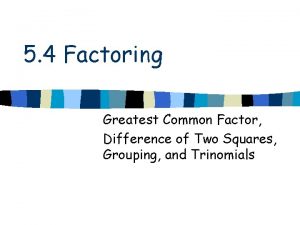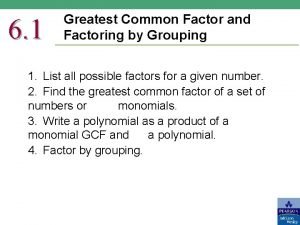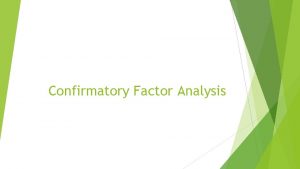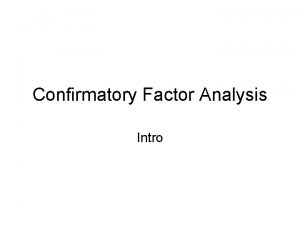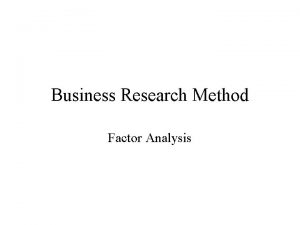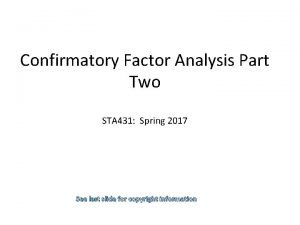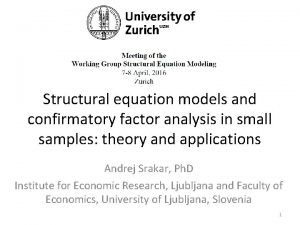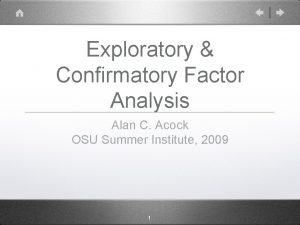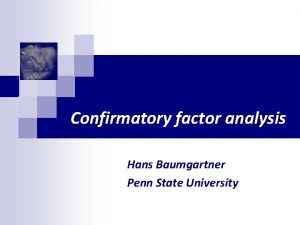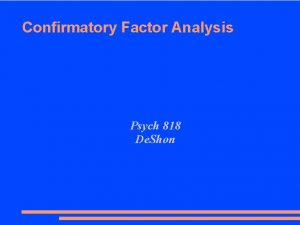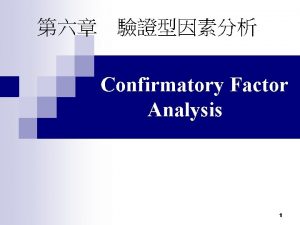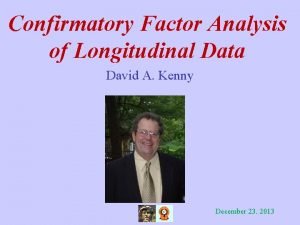The Use of Confirmatory Factor Analysis to Support















- Slides: 15

® The Use of Confirmatory Factor Analysis to Support the Use of Subscores for a Large-Scale Student Outcomes Assessment Rochelle S. Michel, Ph. D. Evaluation 2009 Annual Conference of the American Evaluation Association November 11 -14, 2009

® Introduction • Institutions consistently request assessment information beyond the total score – – Subscores Item analysis Diagnostic information Comparative data 2 Confidential and Proprietary. Copyright © 2009 Educational Testing Service. All rights reserved.

® Introduction • Standard A 4 – Program Evaluation Standards (1994) – Calls for the use of valid information in the evaluation of programs, establishing the validity of inferences drawn from information obtained in relation to the evaluation questions (p. 147) 3 Confidential and Proprietary. Copyright © 2009 Educational Testing Service. All rights reserved.

® Subscores • “Easiest” information that can be provided • Often used as the data by which to measure and document program effectiveness • Research on issues related to subscore reporting – Haberman, 2005; Haberman, Sinharay, Puhan, 2007; • High correlation between subscores and total score • Additional information of subscores beyond total score 4 Confidential and Proprietary. Copyright © 2009 Educational Testing Service. All rights reserved.

® General Education Measure • 108 multiple-choice items • 4 skills (each measured by 27 items) – – Reading Written communication Critical thinking Mathematics • 3 contexts (each measured by 18 items) – Humanities – Social Science – Natural Science 5 Confidential and Proprietary. Copyright © 2009 Educational Testing Service. All rights reserved.

® Research Questions • How well does a four-factor model fit the data from the general education student outcomes measure? • How well does a one-factor model fit the data from the general education student outcomes measure? • What do the results of the CFA indicate about subscore usage for the measure under analysis? 6 Confidential and Proprietary. Copyright © 2009 Educational Testing Service. All rights reserved.

® Demographics • Test takers (n=15, 504) – Gender • Females – 59% • Males – 41% – Ethnicity • White – 75% • African American – 12% • Hispanic – 4% • Institutions (n=54) 7 Confidential and Proprietary. Copyright © 2009 Educational Testing Service. All rights reserved.

® Psychometric Properties • Test reliability, 0. 94 • Skills – – Reading, . 85 Critical Thinking, . 80 Writing, . 77 Math, . 85 • Contexts – Natural Sciences, . 80 – Social Sciences, . 77 – Humanities, . 71 8 Confidential and Proprietary. Copyright © 2009 Educational Testing Service. All rights reserved.

® Correlations among skills Skills Total RD CT W Total 1. 00 RD . 92 1. 00 CT . 90 . 83 1. 00 W . 86 . 75 . 69 1. 00 M . 84 . 66 . 64 . 62 M 1. 00 Note. RD=Reading, CT=Critical Thinking, W=Writing, M=Mathematics 9 Confidential and Proprietary. Copyright © 2009 Educational Testing Service. All rights reserved.

® Correlations among contexts Contexts Total Humanities Natural Sciences Total 1. 00 Humanities . 84 1. 00 Natural Sciences . 89 . 74 1. 00 Social Sciences . 87 . 73 . 78 10 Confidential and Proprietary. Copyright © 2009 Educational Testing Service. All rights reserved. Social Sciences 1. 00

® Confirmatory Factor Analysis • Analyses performed using LISREL 8. 8 (Joreskog & Sorbom, 2006) • Used the tetrachoric correlation matrix to create the covariance matrix to be analyzed • Chi-square statistic – Traditional measure for evaluating overall model fit – Hypothesizes that the model fits the population data perfectly – Both one-factor and four-factor models had statistically significant chi-square values 11 Confidential and Proprietary. Copyright © 2009 Educational Testing Service. All rights reserved.

® Confirmatory Factor Analysis Summary of Fit Indices for the One-Factor and Four-Factor Models of a General Education Measure of Student Outcomes Sample RMSEA ECVI SRMR GFI CFI NNFI M 1 0. 0528 16. 198 0. 0386 0. 770 0. 976 0. 975 M 4 0. 0389 8. 964 0. 0323 0. 858 0. 983 Note. M 1=one-factor model; M 4=four-factor model; RMSEA=root mean square error of approximation; ECVI=expected cross-validation index; SRMR=standardized root mean square residual; GFI=goodness-of-fit index; CFI=comparative fit index; NNFI=non-normed fit index. 12 Confidential and Proprietary. Copyright © 2009 Educational Testing Service. All rights reserved.

® Summary • Results are consistent with previous exploratory factor analysis conducted – Conflicting results between various fit indices – Neither one-factor nor four-factor model provide an appropriate fit to the data 13 Confidential and Proprietary. Copyright © 2009 Educational Testing Service. All rights reserved.

® Implications • Examination of alternative approaches to subscore reporting – Use of scale anchoring methodology/proficiency scaling • Responsible use of current subscores – Total score may provide more information about test takers’ skills than the subscores – Care should be taken making decisions based solely on skill subscores 14 Confidential and Proprietary. Copyright © 2009 Educational Testing Service. All rights reserved.

® Thank you! Thank you to Michael Chajewski and Veleka Allen who performed some of the preliminary analyses on the measure. Contact: rmichel@ets. org 15 Confidential and Proprietary. Copyright © 2009 Educational Testing Service. All rights reserved.
 Confirmatory factor analysis stata
Confirmatory factor analysis stata Mplus syntax
Mplus syntax Luminol blood test
Luminol blood test Confirmation test for staphylococcus aureus
Confirmation test for staphylococcus aureus Exploratory research designs
Exploratory research designs Difference between factor analysis and cluster analysis
Difference between factor analysis and cluster analysis What is signal words
What is signal words Quiz 7-2 factoring by gcf
Quiz 7-2 factoring by gcf Factoring greatest common factor
Factoring greatest common factor Angular frequency to frequency
Angular frequency to frequency Examples of factor relating questions
Examples of factor relating questions Factor gcf
Factor gcf Find the greatest common factor of 24 and 36
Find the greatest common factor of 24 and 36 Hình ảnh bộ gõ cơ thể búng tay
Hình ảnh bộ gõ cơ thể búng tay Slidetodoc
Slidetodoc Bổ thể
Bổ thể
